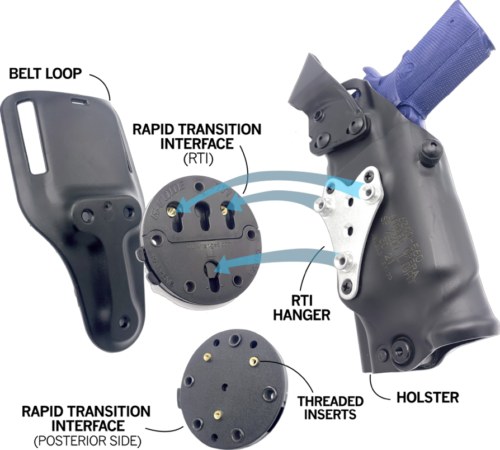
Features
The dangers of after-market police accessories: How can you avoid them?
August 9, 2023 By Geoffrey Desmoulin
 Photo: Markus / Adobe Stock
Photo: Markus / Adobe Stock Police officers face many unexpected challenges and risks each day on the streets, and it’s crucial that they have access to reliable equipment that can help them respond effectively to dynamic and unpredictable situations. However, the market is flooded with new and innovative products that claim to be tactical and efficient for law enforcement officers.
While many departments do not object to the use of aftermarket products, the case of a recent officer-involved shooting1 highlights the potential risks associated with such untested equipment. In this incident, an officer’s holster failed during a struggle with a suspect, which forced the officers to defend themselves with lethal force. Upon investigation, it was found that the failure was not due to the holster itself, but rather an aftermarket product that had been added by the officer. This paper seeks to examine the incident and explore the importance of carefully choosing equipment to ensure the safety and integrity of both officers and the public they serve.
The product involved in this incident was a model of a Rapid Transition Interface (RTI) Wheel (since discontinued), which was ripped from an officer’s belt loop during a dynamic struggle. The purpose of the RTI Wheel is to allow the user to quickly reposition the holster to another location and platform without removing the entire belt loop attachment and for this reason, this optional accessory sits between the holster and the belt loop (as shown in Figure 1). The failure which occurred in this incident was due to the malleability of the material located on the posterior side of the RTI, which allowed its threaded inserts to be pulled out from its back plate.

Credit: GTD Scientific
Testing performed by GTD Scientific in the context of an investigation into this incident revealed that the product’s design made it possible for a determined individual to separate the holster from an Officer’s belt with an effort of approximately 75 per cent of an adult male’s maximal pulling effort in less-than-ideal conditions. Although the magnitude of force involved in this failure was significant, law enforcement officers are expected to be exposed to determined and noncompliant individuals. Therefore, the possibility of this failure should not have taken the officers involved by surprise. Had proper testing been performed to identify this shortcoming, the design could have been improved and therefore the death involved in this incident could potentially have been avoided.
As can be imagined, statements created by advertising teams are a poor substitute for independent testing.
This incident highlights a proposed framework for equipment evaluation that dates back to 2010. Rappert, 20102 proposed that all new less-lethal equipment assessments be guided by four specific principals. The suggested principles are generalizable to all new equipment and when doing so can be reduced to three and are highly applicable here. The adopted three principles are found below.
Principle 1: Police should not be left alone to regulate themselves regarding the evaluation of the equipment they use.
While government forces undergo legal scrutiny, typically much of this activity is restricted to a limited number of non-technical individuals internal to the agencies. This is demonstrated by the wide range of discretion left to individual officers’ choice of equipment. For example, some departments allow officers to purchase their own equipment, while others assign equipment to their officers. The latter may have prevented the incident described above if implemented appropriately to include field tests and biomechanical assessments, but these policies also have drawbacks, such as limiting officer choice and potential innovation. These draw backs could be overcome by testing various popular equipment choices.
Principle 2: Manufacturers’ statement of the efficacy of equipment should not be taken on faith.
Marketing claims should be examined by governmental and non-governmental agencies, not demonstrated by manufacturers. As can be imagined, statements created by advertising teams are a poor substitute for independent testing. One such claim stated that mace reduced assaults on police officers by as much as 50 per cent, but time and experience proved this “statistic” was grossly overestimated (Faulkner & Danaher, 1997).3
Principle 3: Equipment functional uncertainties should be minimized.
By far the most difficult principle to achieve is the goal of understanding new, untested technology and the complex operational environment in which it will be used. It must remain a goal nonetheless as the example above demonstrates. A few steps to achieve this principle are suggested:
- A) Follow scientific methodology;
- B) Avoid obvious risk by exploring material limits of typical equipment use;
- C) Avoid less obvious risk by exploring non-typical use scenarios;
- D) Relate all data back to human capabilities;
- E) Learn from the knowledge produced.
The recent incident involving a holster failure during an officer-involved shooting serves as a stark reminder of the potential risks associated with aftermarket products. Agencies should consider in-house biomechanical testing in-line with the above stated principles to ensure that equipment is both safe and effective. Basic biomechanical testing can provide valuable information in a relatively inexpensive and short amount of time. The results of such testing can potentially save the department thousands in litigation costs, avoidable catastrophic injury and uninformed purchasing of poor performing equipment should it fail in the field.
References
- “Officer Involved Shooting, Suspect broke holster from officer’s duty belt.” San Diego, CA, 2020.
- Rappert, Brian. “A framework for the assessment of non-lethal weapons.” Medicine, Conflict and Survival, 20:1, 35-54. 2004.
- Faulkner S, Danaher L. (1997) Controlling Subjects: Realistic Training vs. Magic Bullets. Accessed at www.fbi.gov/publications/leb/1997/feb974.htm.
Geoffrey T. Desmoulin, PhD., RKin., PLEng., is the Principal of GTD Scientific Inc. in North Vancouver whose core competency is Biomechanical Engineering. He can be reached at gtdesmoulin@gtdscientific.com.
Print this page